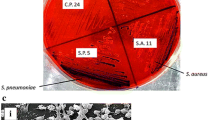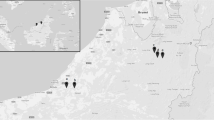Summary
A highly variable carriage rate ofMoraxella catarrhalis has been reported in the literature. In order to assess the reasons for this variability, detection rates of this organism from various sites of the upper respiratory tract of children and adults were studied. Throat swabs, oral swabs and nasal swabs from 131 children, 96 adults and 64 paediatric patients with upper respiratory tract infections were cultured on a selective medium. Detection rates of 31.4% in children less than three years of age, 38.5% in children between 4 and 12 years, 11.7% in adults and 21.9% in patients were found, respectively. The reasons for high variability in the carriage rates were many including the number and site of specimen collection, media used for isolation and identification criteria. All isolates were sensitive to amoxycillin-clavulanic acid and co-trimoxazole. A significantly higher share ofM. catarrhalis isolates from patients were β-lactamase producers (12/14, 85.7%) as compared to normal healthy subjects (41.9%), suggesting a cautious approach in the use of β-lactam antibiotic in respiratory tract infections.
Zusammenfassung
Angaben zum Trägertum vonMoraxella catarrhalis in der Literatur variieren erheblich. Um die Gründe für diese hohe Variabilität zu erhellen, wurden Untersuchungen zum Nachweis dieses Erregers in verschiedenen Abschnitten der oberen Atemwege bei Kindern und Erwachsenen durchgeführt. In einem Selektivmedium wurden Abstriche aus dem Rachen, der Mundhöhle und der Nase von 131 gesunden Kindern, 96 gesunden Erwachsenen und 64 pädiatrischen Patienten mit Infektionen der oberen Atemwege kultiviert. Bei Kindern im Alter von unter drei Jahren betrug die Isolationsrate vonM. catarrhalis 31,4%, bei 4–12jährigen 38,5%, bei Erwachsenen 11,7% und bei Patienten 21,9%. Zahlreiche Faktoren können für die hohe Variabilität in den Carrierraten verantwortlich sein; dazu gehören die Zahl und der Ort der Probenentnahme, die Wahl der Medien für die Isolation und Kriterien für die Identifizierung. Die Empfindlichkeitsprüfung zeigte, daß alle Isolate gegenüber Amoxicillin-Clavulansäure und Co-Trimoxazol empfindlich waren. Bei den Patienten fand sich ein signifikant höherer Anteil an β-Laktamase-Bildnern (12/14, 85,7%) als bei gesunden Trägern mit nur 41,9% β-Laktamase-Bildnern. β-Laktamantibiotika sollten daher bei der Behandlung von Atemwegsinfektionen unter entsprechenden Vorsichtsmaßnahmen eingesetzt werden.
Similar content being viewed by others
References
VanHare, G. F., Shurin, P. A., Marchant, C. D., Cartelli, N. A., Johnson, C. E., Fulton, D., Carlin, S., Kim, C. H. Acute otitis media caused byBranhamella catarrhalis; biology and therapy. Rev. Infect. Dis. 9 (1987) 16–27.
Brorson, J. E., Malmvall, B. E. Branhamella catarrhalis and other bacteria in children with long standing cough. Scand. J. Infect. Dis. 13 (1981) 111–113.
Preliner, K. P., Christensen, B. H., Rosen, C. Nasopharyngeal carriage of bacteria in otitis media-prone and non-otitis-prone children in day care centres. Acta Oto-Laryngol. 98 (1984) 343–350.
Vaneechoutte, M., Verschraegen, G., Claeys, G., Abeele, A. M. V. D. Selective medium forBranhamella catarrhalis with acetazolamide as a specific inhibitor ofNeisseria spp. J. Clin. Microbiol. 26 (1988) 2544–2548.
Schalen, L. P., Christensen, C., Kamme, H., Miorner, K. I., Schalen, C. High isolation rate ofBranhamella catarrhalis from nasopharynx in adults with acute laryngitis. Scand. J. Infect. Dis. 12 (1980) 277–280.
Knapp, J. S., Hook, E. W. Prevalence and persistence ofNeisseria cinerae and otherNeisseria spp. in adults. J. Clin. Microbiol. 26 (1988) 896–900.
Ahmad, F., Mcleod, D. T., Power, J. T., Calder, M. A. Branhamella catarrhalis prevalence in a Hospital population. J. Hosp. Infect. 6 (1985) 71–74.
Vaneechoutte, M., Verschraegen, G., Claey, G., Weise, B., Abeele, A. M. V. D. Respiratory tract carrier rate ofMoraxella (Branhamella) catarrhalis in adults and children and interpretation of isolation ofM. catarrhalis from sputum. J. Clin. Microbiol. 28 (1990) 2674–2680.
Catlin, B. W. Branhamella catarrhalis: an organism gaining respect as a pathogen. Clin. Microbiol. Rev. 3 (1990) 293–320.
Wright, P. W., Wallace, R. J., Shepherd, J. R. A descriptive study of 42 cases ofBranhamella catarrhalis pneumonia. Am. J. Med. 88 (5A) (1990) 2S-8S.
Mannion, P. T. Sputum microbiology in a district general hospital: the role ofBranhamella catarrhalis. Br. J. Dis. Chest 81 (1987) 391–396.
Schonheyder, H., Ejlertsen, T. Branhamella catarrhalis in lower respiratory tract secretions in adults. Eur. J. Clin. Microbiol. Infect. Dis. 8 (1989) 299–300.
Wallace, R. J., Nash, D. R., Steingrube, V. A. Antibiotic susceptibility and drug resistance inMoraxella (Branhamella) catarrhalis. Am. J. Med. 88 (5A) (1990) 46S-50S.
Ejlertsen, T., Schonheyder, H. C., Thisted, E. β-lactamase production inBranhamella catarrhalis isolated from lower respiratory tract secretions in Danish children: an increasing problem. Infection 19 (1991) 328–330.
Powell, M., McVey, D., Kassim, M. H., Chen, H. Y., Williams, J. D. Antimicrobial susceptibility ofStreptococcus pneumoniae, Haemophilus influenzae andMoraxella (Branhamella) catarrhalis isolated in U. K. from sputa. J. Antimicrobial Chemother. 30 (1991) 47–55.
Karnad, A., Alvarez, S., Berk, S. L. Branhamella catarrhalis pneumonia in patients with immunoglobulin abnormalities. South. Med. J. 79 (1986) 1360–1362.
Leinonen, M., Luotenen, J., Herva, E., Valkonen, K., Makela, P. H. Preliminary serological evidence for a pathogenic role ofBranhamella catarrhalis. J. Infect. Dis. 144 (1981) 570–574.
Brown, B. A., Wallace, R. J., Flanagan, C. W. Tetracycline and erythromycin resistance among clinical isolates ofBranhamella catarrhalis. Antimicrob. Agents Chemother. 33 (1989) 1631–1633.
Author information
Authors and Affiliations
Rights and permissions
About this article
Cite this article
Sehgal, S.C., Al Shaimy, I. Moraxella catarrhalis in upper respiratory tract of healthy yemeni children/adults and paediatric patients: Detection and significance. Infection 22, 193–196 (1994). https://doi.org/10.1007/BF01716701
Received:
Accepted:
Issue Date:
DOI: https://doi.org/10.1007/BF01716701




